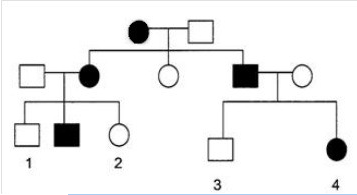Antigens are
A. nonself proteins.
B. proteins on the surface of B-cell membranes.
C. proteins on the surface of macrophage membranes.
D. proteins that consist of two light and two heavy chain polypeptide chains.
E. proteins on the surface of T-cell membranes.
Answer: A
You might also like to view...
This cytoskeletal structure is composed of actin and regulates cell shape, cell movement, and muscle contraction.
A. microfilaments B. intermediate filaments C. microtubules D. both microfilaments and intermediate filaments E. both microfilaments and microtubules
Below is a pedigree of a human genetic disease in which solid color indicates affected individuals. Assume that the disease is caused by a gene that can have the alleles A or a. Based on this pedigree, what is the most likely mode of inheritance?

A) Dominant
B) Recessive
C) Either dominant or recessive
D) Cannot be determined
If you count 24 chromosomes in a body cell, how many chromosomes would you expect to see in the sperm cell of the organism?
1.6 2.12 3.24 4.30
Select the potential problems with using current dispersal barriers (for example, a mountain range) to delineate biogeographical regions. Check all that apply.
A. A barrier for one group of organisms may not be a barrier for another group of organisms. B. Global climate change may change the distribution of taxa and the size and/or location of some of the dispersal barriers. C. The world's biota correspond more closely to political boundaries. D. Human conflicts lead to ever-changing political boundaries. E. Distantly related organisms with similar appearance and habits may exist on either side of a dispersal barrier.